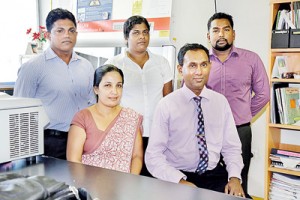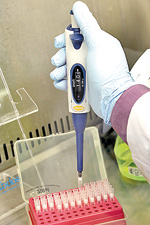The ‘season’ of tiny bugs is upon us
The Christmas and New Year celebrations are over but the ‘season’ of the tiny bugs persists. “Influenza has been doing the rounds, like it usually does since November but don’t be fearful,” urges Consultant Virologist Dr. Jude Jayamaha. For he leads the ‘flu-busters’ of the National Influenza Centre based at the Medical Research Institute (MRI) in Borella.
 The main bug that is currently keeping Sri Lankans under the weather, giving them sore throats, coughs, colds and fever is Influenza A’s sub-type H3N2. Although there are three types of Influenza — A, B and C – only A and B cause significant infections in humans. Influenza C occurs much less frequently than A and B. These influenza viruses are found all over the world. Globally, influenza has an annual attack rate estimated at 5-10% in adults and 20-30% in children.
The main bug that is currently keeping Sri Lankans under the weather, giving them sore throats, coughs, colds and fever is Influenza A’s sub-type H3N2. Although there are three types of Influenza — A, B and C – only A and B cause significant infections in humans. Influenza C occurs much less frequently than A and B. These influenza viruses are found all over the world. Globally, influenza has an annual attack rate estimated at 5-10% in adults and 20-30% in children.
Depending on its surface protein (Haemagglutinin) and enzyme (Neuraminidase), Influenza A can be grouped into several sub-types such as H1N1 and H3N2 which cause human infections, H5N1 and H7N9 which infect birds and other strains which infect mammals including pigs, cats and horses.

The flu-busters -- Consultant Virologist Dr. Jude Jayamaha and Medical Officer Dr. Medhanthi Abeywardhana (seated) with (standing from left) Medical Laboratory Technologists D.H. Priyantha Ekanayake and M.D. Asanka Sanjeewa flanking Health Laboratory Aide K. Ayomi Weerasekara.
The danger of the unpredictable influenza virus, according to Dr. Jayamaha, is that it can change itself (mutate), causing new and more virulent strains. These new strains may spread rapidly causing illness (morbidity), absenteeism both at school and workplace and occasionally leave in their wake death (mortality).
Whenever a new influenza virus spreads within a region it is an epidemic and across continents it is a pandemic. “This has happened over and over again down the ages of time, with the most recent being the Pandemic Influenza A/H1N1of 2009,” says Dr. Jayamaha. “This is why a close eye has to be kept on the influenza virus.”
Advising that prevention is always better, he stresses that failing which if someone does get influenza, it is important to take adequate rest and seek medical help. Another simple tip is to use tissues if a person is having a cold and cough and discard them immediately, after which hand-washing would be a must.
Referring to vaccination, Dr. Jayamaha says it can provide reasonable protection to healthy adults but among the elderly, it may be less effective in preventing illness although it may reduce severity. The National Influenza Centre is recognized by the World Health Organization (WHO) as an influenza diagnostic laboratory. It uses state-of-the-art technology such as PCR (Polymerase Chain Reaction) to feed the Health Ministry with data on which policy decisions are made as well as prevention and control measures are taken for respiratory viruses.
 Working closely not only with the Epidemiology Unit in Sri Lanka but also the Centre for Disease Control in the United States of America, these ‘flu-busters’ carry out extensive collaborative surveillance throughout the country representing each and every district, collecting samples from 17 hospitals dubbed sentinel sites.
Working closely not only with the Epidemiology Unit in Sri Lanka but also the Centre for Disease Control in the United States of America, these ‘flu-busters’ carry out extensive collaborative surveillance throughout the country representing each and every district, collecting samples from 17 hospitals dubbed sentinel sites.
“These samples collected from Outpatients Departments and in-ward patients having severe respiratory diseases show us the patterns and seasonality of influenza,” explains Dr. Jayamaha, adding that they provide crucial clues on what virus and what sub-type of virus are doing the rounds. The team also grows the virus in artificial cell cultures and sends them to the WHO’s Influenza Centre in Melbourne.
Usually, the National Influenza Centre checks around 250-400 samples per month depending on the activity of influenza, but the number rose to more than 5,400 samples for the whole of last year due to a widespread outbreak of influenza, MediScene learns.
The patterns established in Sri Lanka indicate two peaks – a high bout of influenza from December to March and a shorter one from May to July each year. However, a month could shift this way or that, it is understood.



